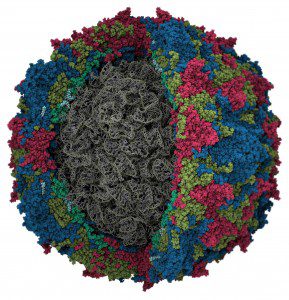

The global withdrawal of the Sabin type 2 poliovirus vaccine is a test of the feasibility of the plan, declared by the World Health Assembly in 1988, to eradicate all polioviruses.
The main vaccine used for the poliovirus eradication effort is an infectious, attenuated preparation called oral poliovirus vaccine (OPV), developed by Albert Sabin. Comprised of all three poliovirus serotypes, it is taken by mouth. During replication in the intestine, it confers immunity to infection and also changes genetically and re-acquires the ability to cause paralysis. These vaccine-derived polioviruses can circulate in the population and cause outbreaks of poliomyelitis.
The last case of paralysis caused by wild (e.g. non-vaccine) poliovirus type 2 occurred in 1999 in India. However, type 2 circulating vaccine-derived polioviruses (cVDPV) continued to cause outbreaks of poliomyelitis. Consequently it was decided, in 2016, to stop immunizing with type 2 OPV. This event was a test for the eventual cessation of immunization with all serotypes of poliovirus vaccine. The important question is whether VDPVs will continue to circulate and pose a threat long after cessation of vaccination, or will vaccine strains disappear?
A new study has provided some answers to these questions. From January 2013 through July 2018, stool samples from 495,035 children with acute flaccid paralysis in 118 countries, and 8528 sewage samples from four countries at high risk for poliovirus transmission were examined for the presence of type 2 OPV or type 2 cVDPV. Type 2 OPV declined in stools from 3.9% in 2016 to 0.2% within 2 months after withdrawal, but was still detected after 12 months.
The continued presence of type 2 OPV in stool can be ascribed to the use of the vaccine to stop outbreaks. After the withdrawal of type 2 OPV, there were 9 outbreaks caused by type 2 cVDPV. These outbreaks occurred in countries with low rates of immunization and consequently low population immunity against poliovirus. These outbreaks took place in the same areas as before the removal of type 2 OPV.
The good news is that all but two 2018 outbreaks in Nigeria were caused by type 2 cVDPV that had been circulating before withdrawal of type 2 OPV. The use of type 2 OPV to control outbreaks has not resulted in widespread circulation of the virus as feared.
It should be noted that the withdrawal of type 2 OPV was accompanied by the recommendation that a dose of trivalent inactivated poliovirus vaccine, a.k.a. Salk vaccine, be given. The use of type IPV should keep population immunity high, inhibiting the circulation of type 2 cVDPVs. Unfortunately due to supply shortages the use of type 2 IPV has not been as extensive as desired.
These findings suggest that circulation of type 2 VDPV can be limited if immunization rates are high in these key regions. Whether or not this goal can be achieved is not known – the areas with low population immunity against poliovirus are typically those with social conditions that prevent adequate vaccination.
The ability to screen thousands of stools and sewage samples and distinguish between type 2 OPV and VDPV is a result of the outstanding surveillance system put in place by the Global Polio Laboratory Network of the Global Polio Eradication Initiative. This system will be essential for monitoring the presence of type 2 polioviruses to determine when they are no longer present and all type 2 immunization can be stopped.
The eradication of wild type 3 poliovirus is imminent – no case has been detected since 2012. Only wild type 1 poliovirus remains – in 2017 there were 22 cases of poliomyelitis caused by type 1 poliovirus (in Afghanistan and Pakistan), and 96 cases caused by type 2 cVDPV. Based on the findings of the type 2 study described here, the withdrawal of both type 1 and type 3 OPV in the future can proceed, but only if high population immunity and careful poliovirus surveillance are maintained.

Pingback: A test of the poliovirus endgame – Virology
Pingback: A test of the poliovirus endgame - Vetmedics
As usual, you offer a wealth of information and historical perspective on polio vaccination efforts to eradicate poliomyelitis. While this is probably in your head from your experience as a virologist over the years. However, it would be helpful to me if you include some references to peer reviewed articles upon which you base your article.